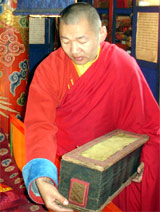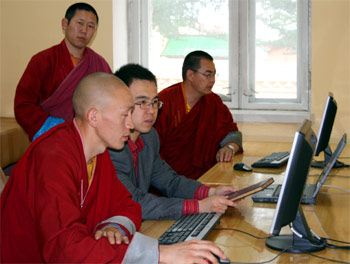UNESCO saves rare archives in Mongolia
20-03-2008 (Beijing)

Gandan Monastery.
© UNESCO
UNESCO is helping the main Mongolian holders of national documentary heritage, the Gandan Tegchenling Monastery and the National Archives, to preserve their unique collections. Several thousands of pages of endangered texts will be saved in digital form and be eventually open to a wider audience.
The centre of Mongolian Buddhists, the Gandan Tegchenling Monastery, is a beautiful ancient structure at the outskirts of Ulaan-Baator city which survived many natural and social disasters. The Monastery harbours a unique collection of scriptures by Mongolian and Tibetan scholars such as Je Zong Kha Pa and his two disciples (Khaidup Je and Gyaltsapa Je), the Dalai Lamas, the Panchen Lamas and Mongolian great philosophers Agvanbaldan, Agvantuvden, Damtsagdorj and Zava Damdin, as well as many others. The scriptures cover a wide range of disciplines such as philosophy, medicine, astrology, traditions of sutra and tantra, linguistics, history, and poetry.
Given that many of these scriptures are the last existing copies, the strong determination of the monks to save their priceless collection by all means comes as no surprise. As the young generation of lamas speaks good English and uses the Internet, they were fast to embrace the concept of e-library which UNESCO put forward at the training workshop on the Preservation of Documentary Heritage in Ulaan-Baator in May 2006.
The workshop was the first and unique opportunity for experts from Mongolia and the Republic of Korea to interact and exchange their views in this highly specialised field. As a very active participant of UNESCO's Memory of the World (MOW) Programme and the host country for the MOW Jikji Prize, the Republic of Korea sent its best preservation experts to Mongolia.
Directors, curators and researchers from various Korean institutions delivered a series of lectures to representatives of the Mongolian National Library, the National Archives, the Ministry of Education, Culture and Science, as well as the Gandan Monastery. As a practical contribution to archival preservation, the Korean side handed over humidifiers, anti-microbial sprays and thermometers to the National Library and the National Archives of Mongolia. Subsequently, two experts from the National Archives of Mongolia were invited for on-site training in the Republic of Korea; on their return, they provided training to archives experts nationwide.
As a follow-up to the training and in response to the request by Venerable Byambajav Kh Da-Lama, UNESCO equipped the library of the Gandan Tegchenling Monastery with the Intranet/Internet connexion, as well as the necessary hard- and software. Six lamas received on-job training on digitalisation techniques of the original texts, e-catalogues and e-books. Until now, 23 volumes, 540 sutras and 8508 pages have been scanned – the slow progress of the work is due to extreme fragility of certain pieces and the complex scroll or tablet structures of sutras. In total 78435 pages of endangered texts will be saved in digital form and be eventually open to a wider audience who wishes to study the spiritual heritage.
UNESCO also assisted another important holder of national documentary heritage, the National Archives of Mongolia, in digitising the technical plans of palace museums of Erdenezuu, Megjid Janraisag, Amarbayasgalant and Bogda Khaan and their engineering and geological references. The biggest record, 231 x 87.07 cm, is now available in its original size. The Archives have chosen to transfer the rest of documents to A-1, A-2 and A-3 formats. Valued by the historians and archaeologists, those documentary treasures totalling to 1545 documents are now accessible on digital carriers.
Both the National Archives of Mongolia and the Gandan Monastery vowed to continue the digitalisation work and to open many documents in their possession to the public either through the Internet or on CD-ROMs.
Given that many of these scriptures are the last existing copies, the strong determination of the monks to save their priceless collection by all means comes as no surprise. As the young generation of lamas speaks good English and uses the Internet, they were fast to embrace the concept of e-library which UNESCO put forward at the training workshop on the Preservation of Documentary Heritage in Ulaan-Baator in May 2006.
The workshop was the first and unique opportunity for experts from Mongolia and the Republic of Korea to interact and exchange their views in this highly specialised field. As a very active participant of UNESCO's Memory of the World (MOW) Programme and the host country for the MOW Jikji Prize, the Republic of Korea sent its best preservation experts to Mongolia.
Directors, curators and researchers from various Korean institutions delivered a series of lectures to representatives of the Mongolian National Library, the National Archives, the Ministry of Education, Culture and Science, as well as the Gandan Monastery. As a practical contribution to archival preservation, the Korean side handed over humidifiers, anti-microbial sprays and thermometers to the National Library and the National Archives of Mongolia. Subsequently, two experts from the National Archives of Mongolia were invited for on-site training in the Republic of Korea; on their return, they provided training to archives experts nationwide.
As a follow-up to the training and in response to the request by Venerable Byambajav Kh Da-Lama, UNESCO equipped the library of the Gandan Tegchenling Monastery with the Intranet/Internet connexion, as well as the necessary hard- and software. Six lamas received on-job training on digitalisation techniques of the original texts, e-catalogues and e-books. Until now, 23 volumes, 540 sutras and 8508 pages have been scanned – the slow progress of the work is due to extreme fragility of certain pieces and the complex scroll or tablet structures of sutras. In total 78435 pages of endangered texts will be saved in digital form and be eventually open to a wider audience who wishes to study the spiritual heritage.
UNESCO also assisted another important holder of national documentary heritage, the National Archives of Mongolia, in digitising the technical plans of palace museums of Erdenezuu, Megjid Janraisag, Amarbayasgalant and Bogda Khaan and their engineering and geological references. The biggest record, 231 x 87.07 cm, is now available in its original size. The Archives have chosen to transfer the rest of documents to A-1, A-2 and A-3 formats. Valued by the historians and archaeologists, those documentary treasures totalling to 1545 documents are now accessible on digital carriers.
Both the National Archives of Mongolia and the Gandan Monastery vowed to continue the digitalisation work and to open many documents in their possession to the public either through the Internet or on CD-ROMs.
 Collection of scriptures of the Gandan Monastery.
Collection of scriptures of the Gandan Monastery.© UNESCO
 Scanning ancient texts in the Gandan Monastery.
Scanning ancient texts in the Gandan Monastery.© UNESCO
Related themes/countries
· Mongolia
· Archives
· Memory of the World: News Archives 2008
· E-Heritage: News Archives 2008
Share this story:














